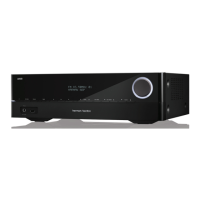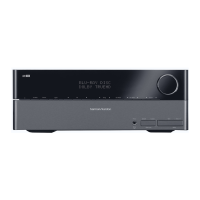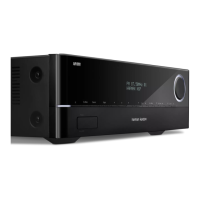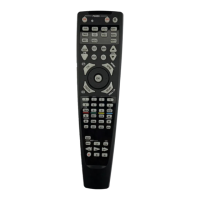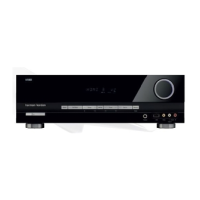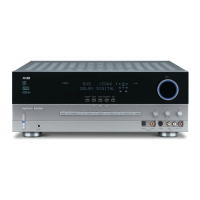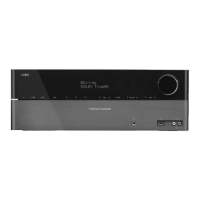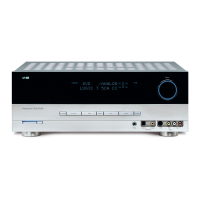
Do you have a question about the Harman Kardon AVR 160 and is the answer not in the manual?
| Receiver type | Surround |
|---|---|
| RMS rated power | 35 W |
| Audio output channels | 7.1 channels |
| Signal-to-Noise Ratio (SNR) | 100 dB |
| Total Harmonic Distortion (THD) | 0.07 % |
| Power output per channel (1KHz@6 Ohm) | 110 W |
| Digital audio coaxial out | 1 |
| Digital audio optical in | 3 |
| Connectivity technology | Wired |
| Speakers connectivity type | - |
| Ethernet LAN | No |
| Supported radio bands | AM, FM |
| Preset stations quantity | 30 |
| Product color | Black |
| Audio decoders | Dolby Digital Plus, Dolby Pro Logic IIx, Dolby TrueHD, DTS 96/24, DTS Neo:6, DTS-ES, DTS-ES (Discrete 6.1), DTS-HD, DTS-HD Master Audio |
| Apple docking compatibility | Not supported |
| Depth | 382 mm |
|---|---|
| Width | 440 mm |
| Height | 165 mm |
| Weight | 10500 g |
Key safety instructions for operating the apparatus safely and correctly.
Guidelines on voltage verification, extension cord usage, and power cord handling.
Statement of compliance with technical standards for product safety and electromagnetic compatibility.
Alerts regarding electrical shock risks and the need for qualified service personnel.
Instructions on not opening the cabinet and ensuring proper ventilation for the unit.
Guidance on placing the unit on a stable surface, away from heat and moisture.
Recommendations for cleaning the unit and avoiding hazardous cleaning agents.
Instructions for safely moving the unit and handling packing materials.
Introduction to the Harman Kardon brand and the AVR 160 receiver's capabilities.
Detailed specifications of the AVR 160's audio section and surround modes.
Overview of the receiver's audio and video input and output connections.
Highlights user-friendly features like EzSet/EQ and on-screen menus.
List of items provided with the AVR 160 receiver.
Description of the power LED modes: Off, Standby (Amber), On (White).
Explanation of Standby/On, RDS, Channel Level, and IR Sensor functions.
Details on Digital Input, Navigation, Set, Message Display, and Tuning buttons.
Functions for selecting and adjusting surround sound modes.
Controls for selecting audio/video sources and inputs.
Headphone/Mic input, Digital Audio Inputs, USB Port, and Video 3 inputs.
Description of the volume knob for adjusting audio levels.
Connections for FM/AM antennas and video monitor outputs.
Inputs for analog component and composite video sources.
Connections for HDMI and other audio/video source devices.
AC power connection and digital audio inputs/outputs.
Connections for speakers, 6-/8-channel audio, CD/Tape, and AUX input.
Buttons for controlling power and selecting input sources.
Buttons for Test Tone, Sleep, Channel, OSD, Level, Digital Input, Tuning Mode.
Buttons for menu navigation, input setup, and tone/RDS controls.
Specific remote functions for HDMI and AUX source devices.
Functions like IR Transmitter, Power, Mute, AVR/Source Selectors, and Test Tone.
Buttons for OSD, Channel Level, Speaker Setup, Digital Input, and Delay.
Buttons for tuning modes, memory, and preset station selection.
Direct station entry, Tone Mode, RDS, Macros, Night Mode, Dim, Transport Controls.
Guidance on the proper disposal of used batteries according to environmental regulations.
Description of components in a typical home theater setup.
Explanation of speaker placement and roles in surround sound systems.
Overview of different surround sound theories and technologies.
Table mapping connector types and colors for audio and video connections.
Instructions for connecting the subwoofer output to the receiver.
Guidance on connecting speakers to the receiver terminals, ensuring polarity.
Introduction to connecting various source components to the AVR.
Details on HDMI, Coaxial, and Optical digital audio connections.
Explanation of RCA, 6-/8-Channel, and Auxiliary analog audio connections.
Overview of digital and analog video connection options.
Instructions for connecting antennas and using the USB port.
Guidelines for positioning center, left, and right front speakers.
Recommendations for placing surround speakers in 5.1 and 7.1 systems.
Tips for optimizing subwoofer placement for best bass response.
Initial steps for planning your system connections and assignments.
Guidance on selecting the optimal video connection type for your system.
Matching source devices to the AVR's conventional source inputs.
Selecting the best video connection for each individual source device.
Selecting the best audio connection type for each source device.
Important considerations for HDMI, DVI, and AUX connections.
Assigning video inputs to sources based on system best practices.
Assigning audio inputs to sources, including digital and analog options.
Connecting external audio and video source components to the AVR.
Connecting the display device to the AVR's monitor output.
Wiring speakers to the AVR's output terminals, ensuring correct polarity.
Connecting the included FM and AM antennas for radio reception.
Instructions for safely connecting the AVR to AC power.
Guide to installing AAA batteries in the remote control.
Steps to program the remote to control various source components.
Procedure for the initial power-on of the AVR 160.
Guide to navigating and using the AVR's on-screen menu interface.
Procedure for automatically calibrating speakers and room acoustics.
Configuring sources, titles, and input connections in the menu.
Adjusting settings like BXR, Tone, Bass, and Treble for audio performance.
Configuring the 6-/8-channel analog audio inputs for specific sources.
Handling complex connections for non-HDMI or no-HDMI display devices.
Adjusting VFD display, volume defaults, HDMI audio, and OSD timeouts.
Controlling the brightness of the AVR's front-panel display.
Instructions for turning the receiver on, off, and entering standby mode.
Adjusting audio volume levels and muting the sound output.
Setting the receiver to automatically turn off after a specified time.
Boosting or cutting treble and bass frequencies for sound customization.
Connecting headphones and using virtual surround processing.
Methods for selecting audio and video sources via front panel or remote.
Steps to resolve issues when no picture is displayed.
Tuning stations, using RDS, and storing presets for AM/FM radio.
Cycling through RDS information like PS, PTY, and RT messages.
Searching for radio stations based on Program Type (PTY) codes.
Connecting recorders and using the auxiliary input for portable devices.
Guide to choosing surround sound modes via the menu system.
Explains Auto Select, Virtual, Stereo, Movie, Music, and Video Game categories.
How the AVR handles analog and digital audio signals.
Details on bitstreams, channels, and formats for surround sound.
Compresses sound levels for quieter listening, with three compression levels.
Step-by-step process for configuring speakers manually.
Adjusting Center Width, Dimension, and Panorama for Dolby modes.
Measuring speaker-to-listener distances for delay compensation.
Navigating the manual setup menus for speaker configuration.
Details on Number of Speakers, Crossover, Sub Mode, Distance, and Level Adjust.
Setting which speaker groups are present in the system.
Defining crossover frequencies for main speakers and subwoofers.
Configuring the subwoofer's signal path based on system configuration.
Entering speaker distances for accurate sound arrival times.
Compensating for audio/video synchronization issues.
Adjusting speaker levels manually using test tone or source material.
Adjusting BXR, Tone, Bass, and Treble settings.
Using Punch-Through, Macros, and remote reset functions.
Default assignments for connecting source components to the AVR.
Default settings for sources, video/audio inputs, auto poll, and surround modes.
Default speaker and channel configurations, including crossovers and sub mode.
Default values for speaker distance and A/V sync delay settings.
Defaults for video, component, digital/analog audio inputs, and auto poll.
Detailed default settings for speaker configuration and levels.
Default remote control codes for various device types.
Default values for system settings like VFD timeout and volume.
Default surround modes associated with Dolby Digital and Pro Logic II.
Detailed explanations of Dolby Pro Logic II/IIx and DTS modes.
Descriptions for DTS-ES, Neo:6, Logic 7, and Stereo modes.
Reference table showing button functions across different device modes.
Setup codes for programming the remote to control televisions.
Setup codes for programming the remote to control VCRs.
Setup codes for programming the remote to control CD players.
Setup codes for programming the remote to control DVD players.
Setup codes for programming the remote to control satellite receivers.
Setup codes for programming the remote to control tape decks.
Setup codes for programming the remote to control cable boxes.
Guide to diagnosing and resolving common operational problems with the AVR.
Steps to reset the AVR to factory default settings.
Information on how user settings are retained during power loss.
Technical details on power output, frequency response, and sensitivity.
Technical details for AM/FM tuner and video sections.
Details on power requirements, dimensions, and weight.
